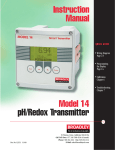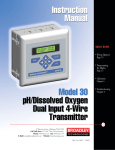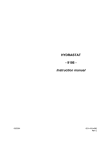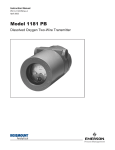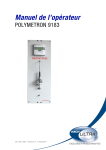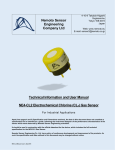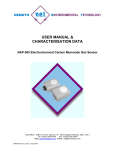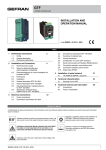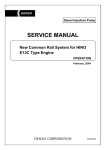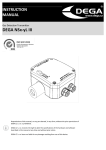Download Broadley Technologies 14 Instruction manual
Transcript
Instruction Manual QUICK GUIDE • Wiring Diagram Page 3-2 • Programming the Display Page 5-13 • Calibration Chapter 6 • Troubleshooting Chapter 7 Model 14 Dissolved Oxygen Transmitter 19 Thomas, Irvine, California 92618 USA Call Toll-Free: 877.246.7900 (USA & Canada) Phone: 949.452.1112 Fax: 949.452.1114 E-Mail: [email protected] Model 14 Oxygen Analyzer Table of Contents Chapter 1 : Introduction ..........................................................................................................1-1 1.1 Introduction.............................................................................................................................1-1 1.2 Principles of Operation............................................................................................................1-1 1.3 Main Characteristics ................................................................................................................1-2 1.4 Technical Specifications ...........................................................................................................1-2 1.5 Dimensions..............................................................................................................................1-4 Chapter 2 : Description of the Analyzer ...................................................................................2-1 2.1 Transmitter ..............................................................................................................................2-1 2.1.1 Presentation of the Transmitter................................................................................2-1 2.1.2 Transmitter Schematic.............................................................................................2-2 2.2 Application Fields ....................................................................................................................2-3 2.3 Standard Mounting Options .....................................................................................................2-3 Chapter 3 : Installation of the Instrument ...............................................................................3-1 3.1 Unpacking................................................................................................................................3-1 3.2 Inspection................................................................................................................................3-1 3.3 Mounting .................................................................................................................................3-1 3.4 Location...................................................................................................................................3-1 3.5 Power Connection....................................................................................................................3-1 3.6 Transmitter Start-Up.................................................................................................................3-1 3.7 Adjusting the Display Contrast..................................................................................................3-1 3.8 Electrical Connections .............................................................................................................3-2 3.9 Terminal Descriptions..............................................................................................................3-3 3.10 Changing the Programming Language ....................................................................................3-4 3.11 Changing the Power Supply Frequency...................................................................................3-5 Chapter 4 : Using the Instrument .............................................................................................4-1 4.1 Front Panel Keys ......................................................................................................................4-1 4.2 Displays 1 - 4...........................................................................................................................4-2 4.3 Description of the Function Keys..............................................................................................4-3 4.4 Icons........................................................................................................................................4-3 4.5 Enter or Modify a Value ...........................................................................................................4-4 Chapter 5 : Programming the Analyzer ....................................................................................5-1 5.1 Main Menu ..............................................................................................................................5-1 5.1.1 CALIBRATION Menu ................................................................................................5-2 5.1.2 MAINTENANCE Menu...............................................................................................5-3 5.1.3 PROGRAMMING Menu.............................................................................................5-3 5.1.3.1 MEASURE Menu.............................................................................................5-4 5.1.3.2 ALARMS Menu ...............................................................................................5-5 5.1.3.3 mA OUTPUTS Menu ......................................................................................5-8 5.1.3.4 RS485 Menu ...............................................................................................5-10 i Model 14 Oxygen Analyzer Table of Contents (Continued) Chapter 5 : Programming the Analyzer (Continued) ...............................................................5-1 5.1.4 SERVICE Menu .....................................................................................................5-11 5.1.4.1 AVERAGE Menu .....................................................................................5-12 5.1.4.2 DISPLAY Menu .....................................................................................5-13 5.1.4.3 CODE Menu ..........................................................................................5-14 5.1.4.4 SOFT VERSION Menu ............................................................................5-15 5.1.4.5 DEFAULT VAL. Menu ..............................................................................5-15 5.1.4.6 mA ADJUST Menu .................................................................................5-16 5.1.4.7 CONFIGURATION Menu.........................................................................5-16 Chapter 6 : Calibrating the Instrument ....................................................................................6-1 6.1 Calibrating the Temperature Sensor .........................................................................................6-1 6.1.1 Automatic Temperature Compensation ...................................................................6-2 6.1.2 Manual Temperature Compensation .......................................................................6-3 6.2 Calibrating the Measurement ...................................................................................................6-4 6.2.1 Slope Calibration in Air with an Electric Zero.........................................................6-4 6.2.2 Slope Calibration in Air with Chemical Zero ...........................................................6-5 6.2.3 Slope Calibration in the Process with an Electric Zero ...........................................6-6 6.2.4 Slope Calibration in the Process with Chemical Zero..............................................6-7 Chapter 7 : Start-up and Troubleshooting................................................................................7-1 7.1 Start-up....................................................................................................................................7-1 7.1.1 Probe Connections .................................................................................................7-1 7.1.2 Main Power Supply Connection ..............................................................................7-1 7.1.3 Starting the Analyzer ...............................................................................................7-1 7.2 Functional Troubleshooting .....................................................................................................7-1 7.3 Troubleshooting the Electronics...............................................................................................7-3 Chapter 8: Error Messages.......................................................................................................8-1 Appendix 1 : Pressure Conversion Table..................................................................................A-1 Appendix 2 : Temperature Conversion Table ...........................................................................A-2 Appendix 3 : Default Values .....................................................................................................A-3 ii Model 14 Oxygen Analyzer Chapter 1: Introduction 1.1 Introduction The Model 14 Dissolved Oxygen Analyzer is a singlechannel analyzer for the measurement of dissolved oxygen in fermentation vessels and bioreactors, as well as in municipal applications. 1.2 Principle of Operation The measurement of dissolved oxygen is based on the well-known Clark cell principle. An oxygen-permeable membrane isolates the electrodes from the sample, thus eliminating the need for sample conditioning. Other reducible or oxidizable ions do not interfere, because they cannot pass through the gas-permeable membrane. ing electrode (cathode) reduces the dissolved oxygen to hydroxyl ions : O2 + 2H2O + 4e- = 4OHA large silver counter electrode (anode) provides the oxidation reaction: 4Ag+ + 4Cl- = 4AgCl + 4eThe reduction of oxygen is the current limiting reaction, thus making the cell current linearly proportional to the dissolved oxygen concentration. Electrochemical reactions and diffusion rates are temperature-sensitive. The measuring cell, therefore, is equipped with a temperature sensor which allows an A constant voltage supply powers two electrodes, main- automatic temperature compensation. taining each at a constant potential. A platinum work- 1-1 Model 14 Oxygen Analyzer 1.3 Main Characteristics ■ Range: 0 - 299.99% saturation; 0 - 29.99 ppm ■ Calibration in the air ■ Temperature compensation ■ Programmable alarm levels, outputs on relays ■ 4-20 mA, 0-20 mA analog outputs (standard) ■ Wall- , panel- and pipe mounting 1.4 Technical Specifications Electrical Characteristics Power Supply Power Consumption Connections Fuse 90 – 265 VAC , 50/60 Hz, Self-adjusting 25 VA Terminal blocks 5x20 mm cartridge - T2AL - 250V ANALYSIS Analysis Number of Inputs Measuring Range Accuracy Reproducibility Response Time (90 %) Ambient Temperature Relative Humidity 1-2 1 0 – 299.99% saturation ± 1% full scale ± 0.1% of range 0 – 95% full scale, <45 seconds -20 – 60 °C (-4 … 140°F) 10 – 90% TRANSMITTER Model 14 Oxygen Analyzer Transmitter Display Units Calibration Analog Outputs Temperature Compensation RS485 (option) Transmitter Protection Error Reports Display in concentration units or % saturation Display of the direct cell current in nA Display of the sample temperature in °C/°F Programming via menus nA, ppm-mg/l, °C, °F, % saturation Electrical zero, chemical zero, slope calibration in the air, slope process calibration by comparison with a laboratory measurement 2 x 0/4 - 20 mA isolated from input signal, 800 ohms load maximum - Measurement or temperature - Mode : linear, bi-linear - Accuracy : 0.1 mA Alarms - Number : 4 - Functions : alarm - system alarm - timer - Hysteresis : 0 - 10% - Delay : 0 - 999 seconds - Breaking power : 250 VAC, 3A maximum 30 VDC, 0.5A maximum Automatic in the range of 0 - 80 °C Speed : 300 - 9600 bauds Insulation : galvanic Station number : 32 maximum IP 65 and NEMA 4X Cell current > 999 nA Sample temperature > 80 °C Ambient temperature > 80 °C Slope calibration error Zero calibration error (offset) Electromagnetic Compatibility Immunity Against Electromagnetic Interferences Electromagnetic Emission Low Voltage Standard EN 50082-2 and EN 50082-1 EN 50081-1 and EN 50081-2 IEC61010-1 MATERIALS Materials Working Electrode Counter Electrode Membrane Holder Membrane Transmitter Probe Body NTE Maintenanace NANCE Cleaning Cathode : platinum Anode : silver PPS & silicone PTFE Epoxy coated aluminum Stainless steel 316L MAI Clean the instrument with a soft tissue. DO NOT use any aggressive agent. 1-3 Model 14 Oxygen Analyzer 1.5 Dimensions (Dimensions are in mm and inches) 144 mm 5.669" 24 mm 0.945" 1-4 Esc 28 mm 1.102" 2 Pg13 Enter 73 mm 2.874" 144 mm 5.669" 117 mm 4.606" 24 mm 0.936" 33.5 mm 1.319" 2 Pg11 Model 14 Oxygen Analyzer Chapter 2: Description of the Analyzer 2.1 Transmitter 2.1.1 Presentation of the Transmitter The electronic unit amplifies the signal of the amperometric measuring cell and converts it into a direct digital readout in ppm, mg/l or % saturation. The transmitter is comprised of the following items: ■ ■ ■ ■ Potentiostat which maintains the working electrode potential constant Amperometric measuring module Analog multiplexer Microprocessor unit The analog multiplexer allows measurement inputs from the measuring cell, temperature sensor and internal checkpoints. Furthermore, the microprocessor operates the relays, the RS485 interface (optional) and the analog outputs. The unit has an internal concentration auto-ranging feature and a microprocessor-operated calibration routine. The output of the potentiostat is monitored for possible overdriving of the potentiostat-output stage. This condition can occur when the connections to the measuring cell are due to an inoperable electrode or a defective reference electrode. 2-1 Model 14 Oxygen Analyzer 2.1.2 Transmitter Schematic: REFERENCE 3 1 ANODE 2 U TEMP + 9 4 TEMP - CATHODE 5 AUX 6 7 1 : Programmable potentiostat 6 : Auxiliary input 2 : Polarization voltage amplifier 7 : Multiplexer 3 : Reversing switch for a 2 or 3 electrode 8 : A/D converter operation. 4 : Temperature measurement circuit 5 : Measurement circuit current amplifier 2-2 9 : Microprocessor 8 Model 14 Oxygen Analyzer 2.2 Application Fields Easy to use, install and program, this instrument is suitable for the following applications: - Fermentation / biotech - Municipal 2.3 Standard Mounting Options (using the red clamping bow) The transmitter housing conforms to norm DIN 43700. 8 mm (0.315”) max. Panel mounting Panel cut-out: 138 mm x 138 mm (5.4” x 5.4”) Front panel dimensions: 144 mm x 144 mm (5.7” x 5.7”) Included hardware: 2 flat head screws, 4 mm x 18 mm long, for panels up to 6 mm thick 285 mm (11.22”) max. 80 mm (3.15") (b) (a) Wall mounting Included hardware: 2 pan head screws, 4 mm x 60 mm long for red clamping bow (a) Additional required hardware: 2 flat head screws, 4 mm x 60 mm long (b) Placed 3.15 “ (80 mm) on center 2-3 Model 14 Oxygen Analyzer Vertical pipe mounting Included hardware: 2 pan head screws, 4 mm x 60 mm long for red clamping bow 42 mm (1.653") max. 2-4 320 mm (12.598") max. Horizontal pipe mounting Included hardware: 2 pan head screws, 4 mm x 60 mm long for red clamping bow Model 14 Oxygen Analyzer Chapter 3: Installation of the Instrument 3.4 Location 3.1 Unpacking The analyzer should be unpacked with great care. The analyzer should be located in an accessible site. Watch for any loose accessories. The site should permit access for any inspection or maintenance operation. 3.2 Inspection 3.5 Power Connection The analyzer has been factory checked and tested prior to shipment. It is advisable, however, to inspect all For safety reasons, it is required to observe the preparts immediately upon receipt for any damage which cautions below: may have occurred during shipping. A damaged shipping container may indicate internal damage, which 1. The instrument should be connected to the power may not be immediately obvious. If there is any evi- supply by means of a breaker located close to the dence of damage, keep the shipping container and instrument and clearly identified. refer to your local agent or to: 2. This breaker should switch off phase and neutral in Broadley Technologies Corporation case of electrical problems or to service the instru19 Thomas, Irvine, CA 92618 USA ment. However, the earth ground must always be con949-452-1112 nected. Toll Free in the US and Canada 877-246-7900 3.6 Starting the Transmitter 3.3 Mounting Before switching on the transmitter, make sure the site voltage corresponds to the instrument voltage indicated on the identification plate. CAUTION! Mounting should be done by qualified service personnel only. No power should be applied until the installation is complete. m 3.7 Adjusting the Display Contrast If the display contrast is not sufficient, adjust the potentiometer P1 (blue color, see figure on page 3-2), which is located on the top left of the CPU board (after opening the enclosure). Before servicing the instrument, confirm the power supply is “off”. 3-1 Model 14 Oxygen Analyzer 3.8 Electrical Connections ■ Model 14 Do not switch the instrument on until completion of the installation. An aluminum armor plate inside the Model 14 gives a detailed description of the different terminals and their connections: ➯ The Relays and Main Power Supply terminals represented on the right side are accessible by removing the armor plate. Preamp. Supply + l1 S1 l2 Relays + S2 S3 / Sys.Alarm RX / TX + RX / TX Temp + Temp NC. Anode GND Cathode GND NC +V GND -V S4 / Timer T 2A L F1 PE Mains Amp. module RS485 (option) Analog Outputs Serial N°: 50 / 60Hz N L 25VA Vac: 90...265V Zellweger Analytics SA / F-93165 Noisy-le-Grand Made in the E.E.C 3-2 Model 14 Oxygen Analyzer 3.9 Terminal Descriptions + + 1 2 RS485 (option) Analog Outputs 0/4 - 20 mA outputs galvanic insulation RX/TX+ RX/TX- Amp module amperometric module Temp+ TempNC Anode Cathode NC Amp module Mains Preamp Supply GND GND +V GND -V PE N L Temp+ TempNC Anode Cathode NC DESCRIPTION 0 - 20 mA or 4 - 20 mA (n°1) [+] 0 - 20 mA or 4 - 20 mA (n°1) [-] 0 - 20 mA or 4 - 20 mA (n°2) [-] 0 - 20 mA or 4 - 20 mA (n°2) [+] RS485 Option DESCRIPTION Temperature sensor [+] Temperature sensor [-] Reference if using 3 electrodes Anode Cathode Auxiliary External shield Internal shield Not used for the oxygen measurement Behind aluminum plate Main power supply, 90...265 VAC 50/60 Hz or 24 V AC/DC (special version) DESCRIPTION Alarm 1, simple contact Alarm 2, simple contact Alarm 3 or alarm system, simple contact Alarm 4 or timer, simple contact CONNECTION user user user user user user COLOR CONNECTION black temp + blue temp not used on the Model 14 oxygen analyzer red Anode white Cathode N.C. braid armor plate brown GND N.C. Ground CONNECTION user user user user ➯ Electrical connections should remain dry to ensure proper operation of the instrument. Check the creeping of the cables when opening the transmitter. ➯ Shielded cables are recommended. This shielding should be connected to the earth central shielding. 3-3 Model 14 Oxygen Analyzer 3.10 Changing the Programming Language The default programming language is English. To change the language, follow the procedure below (example for French): MENU 100 CALIBRATION MAINTENANCE PROGRAMMING SERVICE % Sat 23.2°C Disp2 O2 Select Menu Enter SERVICE DISPLAY Enter CONC: ppm TEMP.: °C PRESSURE: mmHg LANGUAGE: GB Select Select DISPLAY CONC: ppm TEMP.: °C PRESSURE: mmHg LANGUAGE: F Select 3-4 AVERAGE DISPLAY CODE SOFT ISSUE DEFAULT VAL. ADJUST mA CONFIGURATION DISPLAY Enter CONC: ppm TEMP.: °C PRESSION: mmHg LANGUE: F Select Esc (press 3 times) Model 14 Oxygen Analyzer 3.11 Programming the Power Supply Frequency The power supply frequency can be changed if necessary. This change occurs at the initial startup and after resetting the instrument. Follow the procedure below. MENU 100 % Sat 23.2°C Disp2 Enter CALIBRATION MAINTENANCE PROGRAMMING SERVICE O2 Menu Select Enter SERVICE CONFIGURATION FREQ: 50Hz Enter AVERAGE DISPLAY CODE SOFT ISSUE DEFAULT VAL. ADJUST mA CONFIGURATION Select Select DISPLAY DISPLAY FREQ: 60Hz FREQ: 60Hz Enter Esc (press 3 times) 3-5 Model 14 Oxygen Analyzer 3-6 Model 14 Oxygen Analyzer Chapter 4: Using the Instrument 4.1 Front Panel Keys The display may be programmed to indicate : ■ Sample concentration ■ Sample temperature ■ Diffusion current ■ Programming codes ■ Programming features Figure 4-1 : Front Panel 4-1 Model 14 Oxygen Analyzer 4.2 Displays 1 to 4 (live displays) 100% : Dissolved Oxygen measurement S1 S3 100 % Sat 23.2°C S2 Disp2 O2 Menu S1 S4 S3 100% 23.2°C 60.4 nA S2 S1 Display of the parameters measured : % Saturation Temperature Cell current S4 Disp3 S1: S2: S3: S4: 23.2°C : Temperature measurement O2 : Application S1...S4 : Alarm status (invisible if alarm is inactive) ppm >3 OK ppm >5 OK S3 S1...S4 : alarm status In this case relays S1 and S3 are active Disp4 I1: Conc 4.9 mA I2: Conc 4.9 mA Main 4-2 Analog output allocation and level Numeric and bargraph indication Model 14 Oxygen Analyzer 4.3 Description of the Function Keys The function keys below will be highlighted at the bottom of the screen : Modify a parameter Select Scrolling in a list of menus Main Return to the main display Menu Display the main menu Disp2 Display screen 2 Disp3 Display screen 3 Disp4 Display screen 4 OK Validate the measure during calibration Yes Confirm a command - Decrease a value + Increase a value 4.4 Icons Wait for instrument to reset Alarm system for relay S3 Timer symbol : countdown for relay S4 P Controller symbol 4-3 Model 14 Oxygen Analyzer 4.5 Enter or Modify a Value The highlighted digit can be modified with the key . Each digit can be validated by pressing ENTER. Repeat both operations for each digit. 03.89 ppm Increase the digit value 13.89 ppm Enter Validate the digit value 13.89 ppm 15.89 ppm 15.89 ppm Enter Enter 15.89 ppm 15.39 ppm Enter 15.39 ppm 15.37 ppm Enter 15.37 ppm To change the unit 15.37 ppm WARNINGS! Note 1 : If you do not use the keyboard for at least 10 minutes, the instrument returns to the measuring mode. Note 2 : An access code may be required for the CALIBRATION, PROGRAMMING or SERVICE menus (see CODE menu). It is possible to display a negative first digit “-” It is possible to display a “.” for the other digits. 4-4 Model 14 Oxygen Analyzer Chapter 5: Programming the Transmitter 5.1 Main Menu S1 S3 100 % Sat 23.2°C S2 O2 Disp2 Menu S4 MENU CALIBRATION MAINTENANCE PROGRAMMING SERVICE Select CALIBRATION CONC. CALIB. TEMP. CALIB. MAINTENANCE 21.0 ppm PARAMETERS Select Page 5-2 23.2°C 60 nA Page 5-3 PROGRAMMING MEASURE ALARMS mA OUTPUTS RS485 Select Page 5-3 SERVICE AVERAGE DISPLAY CODE SOFT ISSUE DEFAULT VAL. ADJUST mA CONFIGURATION BROADLEY J. Select Page 5-11 5-1 Model 14 Oxygen Analyzer 5.1.1 CALIBRATION Menus ➯ Any calibration should follow the procedure below: 1. Configure the calibration characteristics in the “PROGRAMMING” menu. 2. Perform the calibration via the “EXECUTION” menu. m An access code may be required if one has been programmed, see page 5-14 for CODE Menu. The Temp. Calib. menu will not appear when instrument is set for manual temperature compensation. CALIBRATION Enter CONC. CALIB. TEMP. CALIB. PARAMETERS HISTORIC Enter Select CONC. CALIB. TEMP. CALIB. Enter ZERO EXECUTION SLOPE PARAMETERS DATE: 01/01/98 Select Zero: 0.00nA Select S: 5.40nA/ppm ∆T: 0.0 ˚C Parameters 5-2 DATE mm/dd/yy Date of the last calibration. The date programmed is not updated automatically. S x.xxx nA/ppm Slope value ∆T x.x°C Drift between the theoretical temperature (sensor curve) Th and the temperature measured Tm :DT = Th - Tm Model 14 Oxygen Analyzer 5.1.2 MAINTENANCE Menu MAINTENANCE Used for any maintenance operation in the instrument; the transmitter continues to display the variables measured. The relay status is not modified. 21.0 ppm The relay status is not modified. The analog output value depends on the configuration in the mA OUTPUTS/SPECIAL PROG. /MAINTENANCE menu. 21.6°C 60.5 nA 5.1.3 PROGRAMMING Menu m An access code may be required. See page 5-14 for CODE menu. PROGRAMMING MEASURE ALARMS mA OUTPUTS RS485 Select MEASURE P: 0760.0mmHg TEMP. COMP SALINITY COMP Select Page 5-4 ALARMS ALARMS ALARMS ALARMS ALARMS Select Page 5-5 1 2 3 4 mA OUTPUTS OUTPUT 1 OUTPUT 2 SPECIAL PROG. TEST Select Page 5-8 RS485 N: 00 BAUD : 9600 PARITY : No STOP BIT : 1 Select Page 5-10 5-3 Model 14 Oxygen Analyzer 5.1.3.1 MEASURE Menu PROGRAMMING Enter MEASURE P: 0760.0 mm Hg MEASURE ALARMS mA OUTPUTS RS485 TEMP. COMP. SALINITY COMP. Select Enter Select TEMP. COMP. TYPE: Manual TEMP.: 25.02˚C Select Temperature Compensation TYPE - Auto - Manual Choice of a temperature measurement with automatic compensation or manual compensation When manual temperature compensation is selected, the TEMP.CALIB. menu is no longer accessible! m TEMP. 5-4 - XX.X°C In the case of manual compensation, enter the sample temperature Model 14 Oxygen Analyzer 5.1.3.2 ALARMS Menu Relays S1 through S4 may be allocated to the limit, alarm system or timer functions. PROGRAMMING ALARMS ALARM 1 MEASURE ALARMS mA OUTPUTS RS485 Enter ALARM 2 ALARM 3 ALARM 4 Select Select ➯ LIMIT FUNCTION: The alarm relays are activated when the comparison between the measured value and the programmed limits meets the alarm function condition (up or down). The limits are programmed according to the following programming variables: Limit Alarm Function AFFECT ALARMS AFFECT.: Conc. LIM.: 0.001ppm DIR.: Down DELAY: 000s HYST.: 00% RELAY: NO Select LIM DIR. DELAY HYST. RELAY -Conc. - No -°C/°F XXXX -Up -Down XXXs XX% -NO -NC Programmed for a concentration or temperature limit or not active. Enter a limit value Choice of the direction Time before the relay is executed (in seconds) Definition of the hysteresis limit in % (10% max.). The hysteresis operates on only one side of the limit. The hysteresis is below the limit for the high alarm (up) and above the limit for the low alarm (down). Relay normally open or normally closed 5-5 Model 14 Oxygen Analyzer ➯ SYSTEM ALARM FUNCTION: Relays S3 and S4 may be used as a fault indicater. To control the faults traced by the analyzer, connect the specific relay to an external alarm system. The relay is activated as soon as a default appears. In the case of a manual acknowledgment, the relay remains activated even if the default disappears. Press ENTER to deactivate the relay and the error message. In the case of an automatic acknowledgment, the relay and the error message are deactivated when the default disappears. System Alarm ALARM 3 MODE -No -Limit -System The alarm S3 may be programmed to be a limit function (see paragraph above) or an alarm system function ACCEPT -Auto -Manu. In the case of an alarm system, choose between a manual (key ENTER) or an automatic acknowledgment RELAY -NO -NC Alarm S3 can be normally open or normally closed MODE: System ACCEPT.: Auto RELAY: NC Select 5-6 Model 14 Oxygen Analyzer ➯ TIMER FUNCTION: Relays S3 and S4 may be programmed to a timer function. Timer Function ALARM 4 MODE: Timer INTERV: 1440mm IMPUL. Nb.: 5 Ton: 005s Toff: 003s TmA: 05mn MODE -No -Limit -Timer The Alarm 4 may be a limit (see parameters above) or a timer function INTERV XXXXmn Interval between 2 active cycles (in minutes) IMPUL.Nb: X Number of pulses during an active cycle Ton XXXs Adjustment of the relay active time (in seconds) for each pulse Toff XXXs Adjustment of the relay inactive time (in seconds) for each pulse TmA XXmn Hold time for the analog outputs after each cycle ➯ The analog output status depends on the configuration of the menu mA OUTPUTS/ SPECIAL PROG./TIMER Select The measurement cycle lasts 4 seconds. Example of a timer operating cycle : Relay S4 pulse number Closed Open Time TmA Ton Toff Interval 5-7 Model 14 Oxygen Analyzer 5.1.3.3 mA OUTPUTS Menu The analog output signals allow the transmission of the measurements from the analyzer to any external control system. It is highly recommended to use shielded cables for the output signals. This shielding should be connected to the earth terminal on the armor plate. PROGRAMMING MEASURE ALARMS mA OUTPUTS RS485 mA OUTPUTS Enter OUTPUT 1 OUTPUT 2 SPECIAL PROG. TEST Enter Enter Select Select SPECIAL PROG. OUTPUTS 1/2 MAINTENANCE CALIBRATION SYST. ALARM TIMER Select Enter AFFECT.: Conc. TYPE: 4-20 MODE: Lin LOW: 001 nA UP: 100.0 nA Select Enter TEST VALUE: 00 SPECIAL PROG. MODE: Preset VALUE: 00 Select 5-8 mA mA Model 14 Oxygen Analyzer Output 1/2 AFFECT TYPE MODE LOWER MIDD. UPPER - Conc. - nA - ˚C/˚F - 0/20 - 4/20 - Lin - Dual XXXX XXXX XXXX To set the choice of analog output to the concentration or temperature measurement Choice of the analog output type Choice between a linear or dual range (see drawing below) Bottom scale value Mid-scale value (only in dual mode) Top of the scale value SPECIAL PROG. Special Prog. MODE - last - preset - live VALUE XX Characteristics of the analog output during calibration, alarm system, maintenance or timer active cycles. Display and output will be last stored value, a preset value, or a live measurement Preset value ( 0 to 21 mA) TEST Test the analog outputs in 1 mA increments (0 to 21 mA) Test UPPER MIDDLE LOWER (mA) 20 20 16 15 12 10 8 5 4 0 0 Dual Linear 10 20 30 40 50 60 70 80 90 100 (%) 5-9 Model 14 Oxygen Analyzer 5.1.3.4 RS485 Menu (optional) If the RS485 optional board is installed, program the parameters of the menu below. The optional RS485 board enables a connection between the analyzer and a digital communication system. The communication protocol is JBUS/MODBUS. Call Broadley Technologies for more information. PROGRAMMING MEASURE ALARMS mA OUTPUTS RS485 Select RS485 Enter N: 00 BAUD: 9600 PARITY: No STOP BIT: 1 Select RS485 N° BAUD PARITY BIT STOP 5-10 XX - 300 - 600 - 1200 - 2400 - 4800 - 9600 - No - Odd - Even -1 -2 Enter number (0 – 32) Transmission speed in baud Without parity bit With odd parity bit With even parity bit 1 bit stop 2 bit stop Model 14 Oxygen Analyzer 5.1.4 SERVICE Menu CALIBRATION AVERAGE DISPLAY CODE SOFT ISSUE DEFAULT VAL. ADJUST mA CONFIGURATION BROADLEY J. Select AVERAGE DEFAULT VAL. AVERAGE: 9 Loading TEST SOFT ISSUE m Default Values? Select Yes Model 1400 DO 1.00 DISPLAY ADJUST mA CONC: ppm TEMP: ˚C PRESSURE: mmHg LANGUAGE: GB OUTPUT 1 Select Select CODE CALIF. : 0000 PROG. : 0000 SERVICE : 0000 Select OUTPUT 2 CONFIGURATION FREQ: 60Hz Select 5-11 Model 14 Oxygen Analyzer 5.1.4.1 AVERAGE Menu m An access code may be required. See page 5-14 for CODE menu. Program a moving average on the concentration measurement. The measurement cycle lasts 4 seconds. SERVICE Enter AVERAGE DISPLAY CODE SOFT ISSUE DEFAULT VAL. ADJUST mA CONFIGURATION BROADLEY J. Select AVERAGE AVERAGE: 9 TEST TEST Enter Average 3.46 ppm Real 3.49 ppm Select Average AVERAGE Test 5-12 X Define the number of measurements to calculate the average (1-10) Display the difference between a measurement obtained with and without averaging Model 14 Oxygen Analyzer 5.1.4.2 DISPLAY Menu DISPLAY SERVICE AVERAGE DISPLAY CODE SOFT ISSUE DEFAULT VAL. ADJUST mA CONFIGURATION BROADLEY J. Enter CONC: ppm TEMP: ˚C PRESSURE: mmHg LANGUAGE: GB Select Select Display CONC TEMP. PRESSURE - % sat - ppm - mg/l - °C - °F - mmHg - mbar - inHg LANGUAGE -F - GB -D - Sp -I Choice of measurement units Choice of temperature units Choice of atmospheric pressure units Choice of languages : - French - English - German - Spanish - Italian 5-13 Model 14 Oxygen Analyzer 5.1.4.3 CODE Menu Protection codes may be programmed for access to the PROGRAMMING, CALIBRATION, and SERVICE menus. This code is deactivated by entering 0000. CODE SERVICE AVERAGE DISPLAY CODE SOFT ISSUE DEFAULT VAL. ADJUST mA CONFIGURATION BROADLEY J. CALIB. Enter PROG. : 0000 : 0000 SERVICE: 0000 Select Select Code CALIB. PROG. SERVICE XXXX XXXX XXXX Access code to the “CALIBRATION “ menu Access code to the “PROGRAMMING” menu Access code to the “SERVICE” menu To override the access code, press ESC and ENTER simultaneously to enter the menu selected. 5-14 Model 14 Oxygen Analyzer 5.1.4.4 SOFT ISSUE Menu This menu displays the software version installed in the instrument. SERVICE AVERAGE DISPLAY CODE SOFT ISSUE DEFAULT VAL. ADJUST mA CONFIGURATION BROADLEY J. SOFT ISSUE Enter Model 1400 DO 1.00 Select 5.1.4.5 DEFAULT Menu SERVICE AVERAGE DISPLAY CODE SOFT ISSUE DEFAULT VAL. ADJUST mA CONFIGURATION BROADLEY J. Select m DEFAULT VAL. Loading Enter m Default Values? Yes Pressing YES will load the default values. The current programmed values, historic values and calibration parameters will be lost. 5-15 Model 14 Oxygen Analyzer 5.1.4.6 mA ADJUST Menu The analog output signals are factory-adjusted (upper limit: 20mA). However, if the upper limit of one of the outputs, drifts, the span value can be adjusted with the mA ADJUST menu. Connect an ampere meter in series to the analog output terminals. Adjust the value until the ampere meter displays 20mA. Note: The value displayed does not correspond to an actual mA value. AVERAGE DISPLAY CODE SOFT ISSUE DEFAULT VAL. ADJUST mA CONFIGURATION BROADLEY J. ADJUST mA ADJUST mA SERVICE OUTPUT 1 VALUE: OUTPUT 2 0000 Enter Enter Select Select - + 5.1.4.7 CONFIGURATION Menu The operating frequency must be programmed to match the power supply. When the frequency is changed, the instrument is automatically reset. SERVICE AVERAGE DISPLAY CODE SOFT ISSUE DEFAULT VAL. ADJUST mA CONFIGURATION BROADLEY J. Select CONFIGURATION FREQ: 60Hz CONFIGURATION FREQ: Enter 50Hz Select Enter Please wait … Disp2 Menu Disp2 Start up … Menu Disp2 5-16 Menu Model 14 Oxygen Analyzer Chapter 6: Calibrating the Instrument NOTE See Chapter 5 for programming commands. REMARK Any result (calibration or measurement) is always brought back to the reference temperature (25˚C, 77˚F). If the sample temperature is different from the reference temperature, manual or automatic temperature compensation must be used. 6.1. Calibrating the Temperature Sensor The temperature sensor is located in the dissolved oxygen measurement probe. It is pre-set by the factory, but needs to be calibrated in the sample, on-site. The temperature sensor must be calibrated before calibrating the sensor’s slope and zero. 6-1 Model 14 Oxygen Analyzer 6.1.1. Automatic Temperature Compensation The sensor continuously measures the sample temperature. The concentration values are automatically calculated using the algorithms programmed in the transmitter. 1. Programming PROGRAMMING Enter MEASURE ALARMS mA OUTPUTS RS485 MEASURE Choose automatic temperature compensation. ? P: 0760.0 mm Hg TEMP. COMP SALINITY COMP. Select Enter Select TEMP. COMP. TYPE: Auto. Select 2. Execution TEMP. CALIB. The execution is begun in the CALIBRATION menu. EXECUTION Select Enter 21.2 21.2 ˚C 6.87ppm ˚C CAL 21.2 ˚C CAL OK Press OK when the measurement is stable Can change the value TEMP. CALIB. ∆T: 0.0 ˚C Enter ENTER : ok ESC : cancel 6-2 Enter the sample temperature value in °C. Press OK to adjust the temperature displayed to the actual value of the sample temperature measured with a precise thermometer. The gap between the calibration and the theoretical response curve of the sensor is given for information. Model 14 Oxygen Analyzer 6.1.2. Manual Temperature Compensation Manual temperature compensation should be used only when the sample temperature is constant. 1. Programming PROGRAMMING Enter Select manual temperature compensation. TEMP. COMP MEASURE ALARMS mA OUTPUTS RS485 Select MEASURE Enter Select TEMP. COMP. TYPE: Manual Select Enter TEMP. COMP. TYPE: Manual Enter the sample temperature. TEMP.: 25.0˚ Select 2. Execution Not applicable when manual temperature compensation is selected. 6-3 Model 14 Oxygen Analyzer 6.2. Measurement Calibration The slope calibration can be done in air or water. The zero can be set with an electronic zero or a chemical zero. A chemical zero uses Nitrogen gas or oxygen-free solution. 6.2.1. Slope Calibration in Air with an Electronic Zero Temperature compensation must be set to “auto.” 1. Programming ZERO : Select an electrical zero. The electrical zero is carried out automatically by the transmitter at regular intervals. Select slope in air. CALIBRATION Enter CONC. CALIB. CONC. CALIB. TEMP. CALIB. ZERO PARAMETERS SLOPE Enter Enter Select Select ZERO CALIB. SLOPE CALIB. PROGRAMMING PROGRAMMING EXECUTION Enter Select Select ZERO CALIB. Enter SLOPE CALIB. TYPE: ElectAuto. TYPE: Air SLOPE : Enter the atmospheric pressure in mmHg Enter the ambient temperature in °C ? EXECUTION PO: 760.0 mmHg Tamb.: 20.0 ˚C Select Select 2. Execution SLOPE : Remove the probe from the sample and press ENTER. The probe should be positioned with the membrane downward. SLOPE CALIB. PROGRAMMING EXECUTION Enter Select 21.2 ppm SLOPE CALIB. DATE: 01/01/98 S:3nA/ppm The flashing “CAL” message indicates that the instrument is in calibration mode. Wait for the current to stabilize (approximately 1-2 min.) and press OK to validate the calibration. The oxygen concentration value flashes for 3 seconds. 25.0 ˚C 60.0nA CAL CAL OK Enter the date of the calibration 6-4 The analyzer displays the date of the last calibration and the new slope calculated. The date can be modify. Put the electrode back into service. Model 14 Oxygen Analyzer 6.2.2. Slope Calibration in Air with a Chemical Zero 1. Programming CALIBRATION CONC. CALIB. Enter ZERO : Select a chemical zero Select slope in air CONC. CALIB. TEMP. CALIB. ZERO PARAMETERS SLOPE Select Enter Enter Select ZERO CALIB. SLOPE CALIB. PROGRAMMING PROGRAMMING EXECUTION Enter Select Select ZERO CALIB. Enter SLOPE CALIB. TYPE: Chemical TYPE: Air SLOPE : Enter the atmospheric pressure in mmHg Enter the value of the ambient temperature PO: 760.0 mmHg Tamb.: 20.0 ˚C Select Select 2. Execution ZERO : Place the sensor in 99.999% Nitrogen gas. ZERO CALIB. PROGRAMMING EXECUTION Select Enter 21.2 0 ppm 25.0 ˚C CAL OK ppm 25.0 ˚C Press ENTER, the “CAL” message flashes and indicates the instrument is in calibration mode. Wait for the current to stabilize (approximately 1-2 min.) and press OK to validate the calibration. The oxygen concentration value flashes for 3 seconds. The instrument displays zero. CAL OK 6-5 Model 14 Oxygen Analyzer 6.2.3. Slope Calibration in Process with an Electronic Zero 1. Programming CALIBRATION Enter CONC. CALIB. ZERO : Select the electrical zero. The electrical zero is carried out automatically by the transmitter at a regular frequency. Select process slope. CONC. CALIB. TEMP. CALIB. ZERO PARAMETERS SLOPE Enter Enter Select Select ZERO CALIB. PROGRAMMING SLOPE CALIB. PROGRAMMING EXECUTION Enter Select Select ZERO CALIB. TYPE: ElectAuto. Select Enter SLOPE CALIB. TYPE: Process Select 2. Execution SLOPE CALIB. PROGRAMMING EXECUTION Enter Select 21.2 ppm SLOPE CALIB. DATE: 01/01/98 S:3nA/ppm 25.0 ˚C 60.0nA CAL CAL OK Enter the date of the calibration 6-6 SLOPE : The “CAL” message flashes and indicates the instrument is in calibration mode. Wait for the current to stabilize and press OK. It is possible to adjust the concentration value digit by digit with the function key to the desired value. The analyzer displays the date of the last calibration and the new slope calculated. This date can be modified. Model 14 Oxygen Analyzer 6.2.4. Slope Calibration in Process with a Chemical Zero 1. Programming CALIBRATION Enter CONC. CALIB. CONC. CALIB. TEMP. CALIB. ZERO : Select chemical zero. Select slope process. ZERO PARAMETERS SLOPE Enter Enter Select Select ZERO CALIB. SLOPE CALIB. PROGRAMMING PROGRAMMING EXECUTION Enter Select Select ZERO CALIB. Enter SLOPE CALIB. TYPE: ElectAuto. Select TYPE: Process Select 2. Execution ZERO : Place the sensor in 99.999% Nitrogen gas. ZERO CALIB. PROGRAMMING EXECUTION Select Enter 21.2 0 ppm 25.0 ˚C 5.693nA Press ENTER, the “CAL” message flashes and indicates the instrument is in calibration mode. Wait for the current to stabilize (approximately 10 min.) and press OK to validate the calibration. The oxygen concentration value flashes for 3 seconds. The instrument will display zero. ppm 25.0 ˚C CAL 5.693nA OK CAL OK SLOPE CALIB. PROGRAMMING EXECUTION Enter Select 21.2 ppm SLOPE CALIB. DATE: 01/01/98 S:3nA/ppm 25.0 ˚C 60.0nA CAL SLOPE : The flashing “CAL” message indicates that the instrument is in calibration mode. Wait for the current to stabilize (approximately 10 min.) and press OK to validate the calibration. The oxygen concentration value flashes for 3 seconds. CAL OK The analyzer displays the date of the last calibration and the new slope calculated. This date can be modified. Enter the date of the calibration 6-7 Model 14 Oxygen Analyzer 6-8 Model 14 Oxygen Analyzer Chapter 7: Start-up and Troubleshooting 7.1 Start-up 7.1.1 Probe Connection PROBLEM: No significant current increase when the probe is in the air during calibration See page 3-3 for the terminal connection. Causes and solutions: 7.1.2 Main Power Supply Connection A) The membrane has been torn. ➯ Change the membrane. Remove aluminum plate inside the Model 14. Power should be connected to the “Mains” terminal indicated B) Cable or connections have been damaged. on the plate. See Page 3-3 for terminal connections. ➯ Check the connection to the transmitter. If the connection is correct check the connections 7.1.3 Starting the Analyzer of the probe connector. When switched on, the analyzer performs an automatic test of its electronics and displays a first value. Wait until the measurement has stabilized (max. 30 min). Do not calibrate the analyzer before the temperature and the concentration are stable. (See Chapter 6.) PROBLEM: Significant instability in measuring mode Causes and solutions: Note 1: Never shake the probe during a calibration, it may provoke an introduction of oxygen in the elec- A) There is humidity or water in the probe connector. trolyte and temporarily increase the cell current. ➯ Dry the connector. Check connections. 7.2 Functional Troubleshooting PROBLEM: Excessive time for stabilization or no stabilization during air calibration. Causes and solutions: B) Incorrect connection. ➯ Check the connections of the transmitter to the probe. C) Electromagnetic interferences close to the probe or transmitter cable. ➯ Find a better place for the cable and check the EMC level. A) There is an electrolyte leak (through the membrane). The current is too high because of an excessive penetration of oxygen. ➯ Change the membrane. B) The electrolyte is contaminated. ➯ Change the electrolyte. 7-1 Model 14 Oxygen Analyzer PROBLEM: Inaccurate readings Other problems Causes and solutions: Causes and solutions: A) The membrane permeability has changed (coating). ➯ Calibrate the analyzer and check if the concentration is back to normal. A) The probe current is zero. ➯ There is no electrolyte in the probe (leak). There may be a short-circuit in the connection. B) Electrolyte contamination. ➯ Inspect probe components. Change the electrolyte. B) The probe current is negative. ➯ Connection problem to the anode circuit (loose contact). ➯ Deposits on the anode. C) Leak of electrolyte. ➯ Inspect probe components. Change the electrolyte. D) Error during calibration or incorrect calibration. ➯ Calibrate again to check the parameters. If the error is confirmed, check the calibration current (too high, too low or unstable) and the concentration in the air. Refer to the problems described above. E) The temperature calibration has not been performed. ➯ Check the temperature given by the transmitter and calibrate it (see page 6-2). If manual compensation has been selected, confirm the value is correct. F) The sample temperature or pressure is out of the specifications. ➯ Change the probe location or modify the sample so that it meets the specifications. 7-2 C) The sample temperature corresponds to the specifications, but there is an error on the temperature. ➯ There may be a short-circuit on the temperature connection. Model 14 Oxygen Analyzer 7.3 Troubleshooting the Electronics WARNING! Never attempt to service before disconnecting the instrument from the main power line. MALFUNCTION POSSIBLE CAUSE REMEDIES No indication No power; instrument is not connected correctly Check for power, then check if connected properly Defective fuse Check fuse Instrument’s power supply set for wrong line voltage Check jumpers on power supply board for correct voltage settings Ribbon cable connecting power with CPU board not properly plugged in Verify that the ribbon plugs are connected properly Connection between CPU board and measurement module loose Check plug connections Short circuit in power supply board Visually check power supply board for shorts Hardware is defective Call the Service Technician Malfunctioning CPU board or processor Using the Instruction Manual, program the instrument to load the default values CPU hardware RESET the instrument by temporarily interrupting the power (5-10 seconds) LCD displays undefined characters Call the Service Technician Keyboard does not operate; all keys are inactive CPU malfunctioning, external interferences If there is no response, RESET the instrument by temporarily interrupting the power (5-10 seconds). Check each key again. If there is no change, call the Service Technician. Measurement is not correct Instrument was programmed incorrectly Recheck programmed parameters. Do they agree with the probe’s characteristics? System, including probe, not calibrated correctly Calibrate the whole system (with probe connected) Probe connected wrong Recheck all probe connections Probe malfunctioning, possibly incompatible with the application Visually check the condition of the probe. Is the application within the probe’s specifications? CPU board is defective If error persists, call the Service Technician Measurement is not stable Faulty probe Probe connected wrong Check the condition of the probe. Is it contaminated? Verify the probe is connected properly 7-3 Model 14 Oxygen Analyzer MALFUNCTION Temperature measurement is not correct Display reading static; cannot be changed in any way POSSIBLE CAUSE REMEDIES Interferences Are there any sources of potential interference, chemical, external, temperature, pressure, etc.? Cable shield is not connected Check and connect Defective CPU board If problem persists, call the Service Technician Probe connected wrong Check probe connection Temperature not calibrated Calibrate for temperature. Also check the T.C. for correct resistance (ohmmeter) CPU board is defective If problem persists, call the Service Technician CPU board is malfunctioning and/or some other transmitter hardware is defective Check probe connection Initiate a software RESET If Steps 1-3 do not remedy the problem, make a cold start (RESET): interrupt the power for 5-10 seconds Reprogram the instrument If problem persists, call the Service Technician Relays not energized Instrument was programmed incorrectly Check whether the correct relay parameters and set points have been programmed Hardware is defective Check that the programmed set points are compatible with the programmed measuring range Check the relay characteristics for proper functioning using an ohmmeter If problem persists, contact the Service Technician Wrong output current, output current remains locked at 0 or 20 mA Instrument was incorrectly programmed Check the programmed output-current parameters Connection of the Model 14 with peripherals (recorder, etc.) are faulty, loose or defective Check the cables Hardware is defective Compare the measured value with the output-current range If problem persists, call the Service Technician Polarization voltage incorrect Wrong configuration (3 electrode mode) Wrong programming Check programmed parameters 7-4 Check that the switches under the amperometric board are correctly positioned (“on”) Model 14 Oxygen Analyzer Chapter 8: Error Messages During failure, the measurement is replaced by dashes “ - - -.” Error Message Description Error messages during a measurement - - CONCENTRATION TOO HIGH - - STAND-BY 1.99 ppm The concentration value exceeds the limits. Check the current value and the calibration parameters. Electrode protection If the measuring range displays “concentration too high” for more than 2 minutes, the error message “STAND-BY” appears. From this moment on, the electrode polarization voltage is switched off for 10 minutes before the voltage is switched on again. In STAND-BY the user may switch the voltage on at any time by pressing ENTER. The concentration value exceeds the limits. Check the current value and the calibration parameters. The sample temperature exceeds the limits. Check the cable polarity. Check for a short-circuit or an open circuit. The current value exceeds the limits. Check the electrode (electrolyte and membrane). 8-1 Model 14 Oxygen Analyzer The current value exceeds the limits. Confirm there is no short-circuit in the measuring line. Check the polarization voltage. Error messages during calibration 21.6 ˚C ∆T OUT OF LIMITS 8-2 The temperature difference between the calibration temperature and the sensor’s theoretical exceeds the limit programmed. Limits : ± 20°C Model 14 Oxygen Analyzer Appendix 1: Pressure Conversion Table hPa or mbars mm Hg psi inches Hg 690 mm H2O 9503.60 13.34 27.16 inches H2O 374.16 920.00 925.00 693.8 9555.25 13.42 27.31 376.19 930.00 697.5 9606.90 13.49 27.46 378.22 935.00 701.3 9658.55 13.56 27.61 380.26 940.00 705 9710.20 13.63 27.76 382.29 945.00 708.8 9761.85 13.71 27.90 384.32 950.00 712.5 9813.50 13.78 28.05 386.36 955.00 716.3 9865.15 13.85 28.20 388.39 960.00 720 9916.80 13.92 28.35 390.43 965.00 723.8 9968.45 14.00 28.50 392.46 970.00 727.5 10020.10 14.07 28.64 394.49 975.00 731.3 10071.75 11.14 28.79 396.53 980.00 735 10123.40 14.21 28.93 398.56 985.00 738.8 10175.05 14.29 29.08 400.59 990.00 742.5 10226.70 14.36 29.23 402.63 995.00 746.3 10278.35 14.43 29.38 404.66 1000.00 750 10330.00 14.50 29.53 406.69 1005.00 753.8 10381.65 14.58 29.68 408.73 1010.00 757.5 10433.30 14.65 29.82 410.76 1015.00 761.3 10484.95 14.72 29.97 412.79 1020.00 765 10536.60 14.79 30.12 414.83 1025.00 768.8 10588.25 14.87 30.27 416.86 1030.00 772.5 10639.90 14.94 30.42 418.89 A-1 Model 14 Oxygen Analyzer Appendix 2: Temperature Conversion Table • Conversion from ˚C into ˚F : • Conversion from ˚C into ˚K : A-2 ˚F = 1.8 * ˚C + 32 ˚K = ˚C + 273.15 ˚C ˚F ˚K ˚C ˚F ˚K 0 32 273.15 23 73.4 296.15 1 33.8 274.15 24 75.2 297.15 2 35.6 275.15 25 77 298.15 3 37.4 276.15 26 78.8 299.15 4 39.2 277.15 27 80.6 300.15 5 41 278.15 28 82.4 301.15 6 42.8 279.15 29 84.2 302.15 7 44.6 280.15 30 86 303.15 8 46.4 281.15 31 87.8 304.15 9 48.2 282.15 32 89.6 305.15 10 50 283.15 33 91.4 306.15 11 51.8 284.15 34 93.2 307.15 12 53.6 285.15 35 95 308.15 13 55.4 286.15 36 96.8 309.15 14 57.2 287.15 37 98.6 310.15 15 59 288.15 38 100.4 311.15 16 60.8 289.15 39 102.2 312.15 17 62.6 290.15 40 104 313.15 18 64.4 291.15 41 105.8 314.15 19 66.2 292.15 42 107.6 315.15 20 68 293.15 43 109.4 316.15 21 69.8 294.15 44 111.2 317.15 22 71.6 295.15 45 113 318.15 Model 14 Oxygen Analyzer Appendix 3: Default Values Calibration CONC. CALIB. ZERO CALIB. Type : Elec. Auto SLOPE Type : Air PO: 0760.0 mm Hg PARAMETERS DATE :01/01/98 ZERO: 0.00 nA S: 3.000 nA/ppm ∆T: 0.0˚C Programming MEASURE TEMP. COMP. TYPE : Auto ALARMS S1/S2/S4 AFFECT. : Conc. DIR. : Down LIMIT: 0.000 ppb DELAY : 000 s HYST. : 00% RELAY : NO OUTPUT 1 AFFECT. : Conc. TYPE : 4-20 MODE : Lin. LOW : 0.000 ppb UP : 01.00 ppm MAINTENANCE MODE : Last SYST. ALARM MODE : Last ALARMS ALARM S3 AFFECT. : System ACQUIT : Auto RELAY : NC mA OUTPUTS OUTPUT 2 AFFECT. : Conc. TYPE : 4-20 MODE : Lin. LOW : 0.000 ppb UP : 01.00 ppm SPECIAL PROG. CALIBRATION MODE : Last TIMER MODE : Last RS485 No : 00 BAUD : 9600 PARITY : No STOP BIT : 1 SERVICE A-3 Model 14 Oxygen Analyzer Service AVERAGE AVERAGE : 1 DISPLAY DISPLAY CONC. : ppb/ppm TEMP. : °C PRESSURE : mmHg LANGUAGE : GB CODE CODE CALIB. : 0000 PROG. : 0000 SERVICE : 0000 CONFIGURATION CONFIGURATION FREQ. : 60 Hz A-4 Model 14 Oxygen Analyzer Broadley Technologies Corporation 19 Thomas Irvine, California 92618 USA Corporate Headquarters: Toll-Free: 877.246.7900 Tel: 949.452.1112 Fax: 949.452.1114 E-Mail: [email protected] Copyright © 2000 Broadley Technologies Corporation All Rights Reserved A-5
























































